 W
W50 Greatest Magic Tricks is a one-off list show that was produced by Objective Productions for Channel 4. The programme counted down the fifty greatest magic tricks, as voted for by members of The Magic Circle. The illusion at number one was Death Saw by David Copperfield. The show was presented by British comedy duo Adam and Joe, who also wrote and narrated the programme. The show was first broadcast on Channel 4 on 6 May 2002.
 W
WThe Assistant's Revenge is a transposition illusion in which two performers change places. It was created by magician and inventor Robert Harbin.
 W
WThe Aztec Lady is a stage illusion designed by British magician Robert Harbin. It is a classic "big box" illusion that involves an assistant in a cabinet and is probably best categorised as a restoration-type illusion.
 W
WBillet reading, or the envelope trick, is a mentalist effect in which a performer pretends to use clairvoyance to read messages on folded papers or inside sealed envelopes. It is a widely performed "standard" of the mentalist craft since the middle of the 19th century. Billet is the French term for note or letter, referring to the rectangular shape of the paper.
 W
WCard manipulation is the branch of magical illusion that deals with creating effects using sleight of hand techniques involving playing cards. Card manipulation is often used to perform card tricks in magical performances, especially in close-up, parlor, and street magic. A person who practices card manipulation may be called a card sharp, card shark, or card mechanic.
 W
WChink-a-chink is a simple close-up magic coin trick in which a variety of small objects, usually four, appear to magically transport themselves from location to location when covered by the performer's hands, until the items end up gathered together in the same place. Variations, especially the Sympathetic Coins also known as Coins-n-Cards, have been performed since the 1800s. Popular modern variations are Shadow Coins and Matrix. A variation using playing cards as the objects is known as Sympathetic Aces.
 W
WCoins Through Table is considered to be a classic of coin magic, where a magician appears to make coins penetrate a table. Being one of the most popular forms of coin magic, it is described in many magic books with many variations.
 W
WChink-a-chink is a simple close-up magic coin trick in which a variety of small objects, usually four, appear to magically transport themselves from location to location when covered by the performer's hands, until the items end up gathered together in the same place. Variations, especially the Sympathetic Coins also known as Coins-n-Cards, have been performed since the 1800s. Popular modern variations are Shadow Coins and Matrix. A variation using playing cards as the objects is known as Sympathetic Aces.
 W
WThe cups and balls is a performance of magic with innumerable adaptations. Street gambling variations performed by conmen were known as Bunco Booths. A typical cups and balls routine includes many of the most fundamental effects of magic: the balls can vanish, appear, transpose, reappear and transform. Basic skills, such as misdirection, manual dexterity, sleight of hand, and audience management are also essential to most cups and balls routines. As a result, mastery of the cups and balls is considered by many as the litmus test of a magician's skill with gimmick style tricks. Magician John Mulholland wrote that Harry Houdini had expressed the opinion that no one could be considered an accomplished magician until he had mastered the cups and balls. Professor Hoffman called the cups and balls "the groundwork of all legerdemain".
 W
WDavid Copperfield's laser illusion is an illusion performed by David Copperfield in several magic shows. The magician or his assistant is cut by a "laser" into two or more parts and starts walking.
 W
WThe detachable thumb is a close-up illusion.
 W
WThe Devil's Torture Chamber is a magic stage illusion of the classic type involving a female magician's assistant in a large box and is probably best categorised as a penetration or restoration-type illusion.
 W
WThe Drill of Death is a large-scale stage illusion in which a performer appears to be impaled on a giant drill. It was created by magician André Kole and illusion designer Ken Whitaker for magician Melinda Saxe. It was one of Saxe's signature tricks and featured as a highlight in her various First Lady of Magic shows.
 W
WEscapology is the practice of escaping from restraints or other traps. Escapologists escape from handcuffs, straitjackets, cages, coffins, steel boxes, barrels, bags, burning buildings, fish-tanks, and other perils, often in combination.
 W
WA thumb tip is a magician's prop designed to fit over and appear to be the magician's thumb used for vanishing, producing, or switching small objects. A classic effect is to have a silk handkerchief or other small object pressed into the top of the left fist. After pushing it well in with the right thumb, the left fist is opened to show the silk has disappeared. Alternatively, a lit cigarette, liquid, salt or other small objects can be made to disappear in a similar manner.
 W
WThe French drop, also known as "Le Tourniquet", is a sleight of hand method used by magicians to vanish a small object such as a coin or ball. It is one of the oldest methods of vanishing, however it is still effective when properly executed. Although the method is known as a vanish, it can also be used as a switch or transformation, giving rise to numerous possibilities.
 W
WThe hat-trick is a classic magic trick where a performer will produce an object out of an apparently empty top hat.
 W
WIndian Basket Trick is a trick with a wicker basket in which an assistant is put into the basket and the performer then puts swords through it. The trick ends while the child or assistant either climbs out of the basket or reappears from behind the crowd unharmed. The Indian Basket trick has been used in an adapted form by Western magicians for a long time. It is one of the oldest illusions. It started off being performed in the streets; later, Colonel Stodare adapted it to stage magic. In the old version of the Indian Basket Trick, the magician used a real basket for the trick. Nowadays magicians use a box to accomplish this trick.
 W
WA levitation illusion is one in which a magician appears to defy gravity by making an object or person float in the air. The subject may appear to levitate unassisted, or it may be performed with the aid of another object in which case it is termed a "suspension".
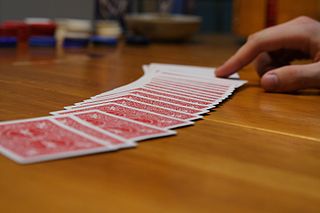 W
WIn stage magic, a force is a method of controlling a choice made by a spectator during a trick. Some forces are performed physically using sleight of hand, such as a trick where a spectator appears to select a random card from a deck but is instead handed a known card by the magician. Other forces use equivocation to create the illusion of a free decision in a situation where all choices lead to the same outcome.
 W
WMetamorphosis is the name of a stage illusion invented by John Nevil Maskelyne, but most often associated with famous escape artist Harry Houdini and performed to some renown by The Pendragons, among others. It is also known amongst magicians as the Substitution Trunk.
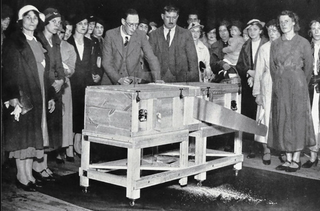 W
WSawing a woman in half is a generic name for a number of stage magic tricks in which a person is apparently sawn or divided into two or more pieces.
 W
WMuscle reading, also known as "Hellstromism", "Cumberlandism" or "contact mind reading", is a technique used by mentalists to determine the thoughts or knowledge of a subject, the effect of which tends to be perceived as a form of mind reading. The performer can determine many things about the mental state of a subject by observing subtle, involuntary responses to speech or any other stimuli. It is closely related to the ideomotor effect, whereby subtle movements made without conscious awareness reflect a physical movement, action or direction which the subject is thinking about. The term "muscle reading" was coined in the 1870s by American neurologist George M. Beard to describe the actions of mentalist J. Randall Brown, an early proponent of the art.
 W
WThe ouija, also known as a spirit board or talking board, is a flat board marked with the letters of the alphabet, the numbers 0–9, the words "yes", "no", occasionally "hello" and "goodbye", along with various symbols and graphics. It uses a planchette as a movable indicator to spell out messages during a séance. Participants place their fingers on the planchette, and it is moved about the board to spell out words. "Ouija" is a trademark of Hasbro, but is often used generically to refer to any talking board.
 W
WPalming is a technique for holding or concealing an object in the hand. It is used frequently by magicians to conceal a card, coin, or other object. When it is done skillfully, the hand containing the palmed object is perceived to be completely empty.
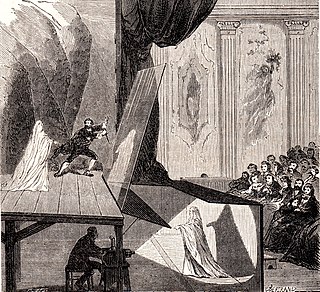 W
WPepper's ghost is an illusion technique used in the theatre, cinema, amusement parks, museums, television, and concerts.
 W
WPolka dot paint is a paint of "polka dot color", i.e., a paint which paints an object with a polka dot pattern.
 W
WA predicament escape is any form of magic trick or escapology stunt in which the performer is trapped in an apparently dangerous situation and is required to escape from it. Classic examples include the Table of Death, Houdini's Chinese Water Torture Cell, Princess Tenko's escape from an exploding boat and the Upside Down Suspended Straitjacket escape, in which a performer is suspended high in the air from a burning rope.
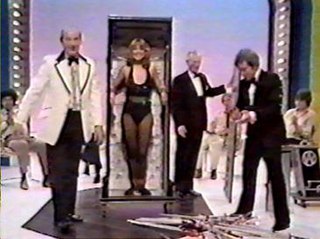 W
WThe Radium Girl is a stage illusion of the classic type involving a female assistant in a large box and is probably best categorised as a penetration or restoration-type illusion. Its origins and history are much less well documented than those of many other "big box" illusions but some sources indicate it might be one of the earliest examples of that type of trick. References and picture captions indicate it was the creation of British magician and designer Val Walker.
 W
WSawing a woman in half is a generic name for a number of stage magic tricks in which a person is apparently sawn or divided into two or more pieces.
 W
WSmoke and mirrors is a classic technique in magical illusions that makes an entity appear to hover in empty space. It was documented as early as 1770 and spread widely after its use by the charlatan Johann Georg Schröpfer, who claimed the apparitions to be conjured spirits. It subsequently became a fixture of 19th-century phantasmagoria shows. The illusion relies on a hidden projector the beam of which reflects off a mirror into a cloud of smoke, which in turn scatters the beam to create an image.
 W
WA snapper is a mechanical puzzle consisting of a pointed piece attached to a notched dowel and a hollow block with a secondary hole along its length through which a rubber-band is stretched and tied off. A demonstrator inserts the dowel into the hollow block, hooks the rubber-band on the notch, pulls on the pointed end, and allows the dowel to snap back into place. The demonstrator hands the puzzle to an observer who cannot hook the rubber-band onto the dowel's notch. The demonstrator takes the puzzle back and makes it snap immediately. The trick is that the ends of the dowel are tapered so that the demonstrator can squeeze the fingers holding it together, causing it to snap into the block.
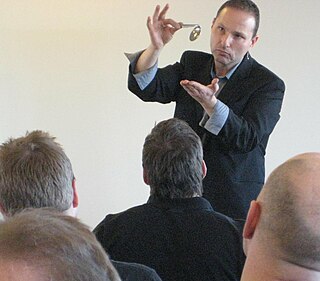 W
WSpoon bending is the apparent deformation of objects, especially metal cutlery, either without physical force, or with less force than would normally seem necessary. It is a common theme for magic tricks, which use a variety of methods to produce the effect.
 W
WChink-a-chink is a simple close-up magic coin trick in which a variety of small objects, usually four, appear to magically transport themselves from location to location when covered by the performer's hands, until the items end up gathered together in the same place. Variations, especially the Sympathetic Coins also known as Coins-n-Cards, have been performed since the 1800s. Popular modern variations are Shadow Coins and Matrix. A variation using playing cards as the objects is known as Sympathetic Aces.
 W
WA thumb tip is a magician's prop designed to fit over and appear to be the magician's thumb used for vanishing, producing, or switching small objects. A classic effect is to have a silk handkerchief or other small object pressed into the top of the left fist. After pushing it well in with the right thumb, the left fist is opened to show the silk has disappeared. Alternatively, a lit cigarette, liquid, salt or other small objects can be made to disappear in a similar manner.